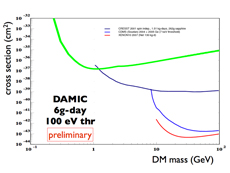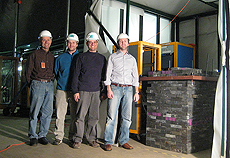DAMIC's search for light mass dark matter candidates

The upper limit on the cross section allowed for weakly interacting dark matter candidates as a function of mass. Preliminary results are shown in green and significantly extend the reach in the low mass region.
Scientists believe that dark matter is five times more prevalent than the visible matter that comprises our stars and planets. Yet scientists do not know much about these mysterious particles, other than the particles' collective effects, for instance, on galactic rotation.
Previous experiments have searched for the tiny recoil of a nucleus
that scientists would observe if a high-mass dark matter particle
from our own galaxy were to collide with an Earthbound detector as the Earth sails through the Milky Way.
Now, a new Fermilab experiment called DAMIC (Dark Matter In CCDs) is searching for light dark matter candidates with masses less than that of a proton [1 GeV/c2] or two. According to theorist Kathryn Zurek, "models that explain why the dark matter and baryon abundances are about the same relate the dark matter mass to the proton mass, so the dark mass is quite generically a few GeV/c2 in this class of models."
DAMIC makes use of CCDs originally developed to image a telescope for the Dark Energy Survey experiment. The CCDs are a better version of the same technology used in everyday digital cameras. They record snapshots of the charge that would be created if dark matter were to collide with the CCD volume. To reduce backgrounds for DAMIC, the tiny detectors are enclosed in 10 tons of lead shielding, maintained at minus 150 degrees Celsius and kept in a dust-free clean room in a tunnel more than 100 meters underground.
DAMIC spokesperson Juan Estrada explains that with this new CCD technology, "we can set a threshold for nuclear recoils that is lower than others have been able to do, making us more sensitive to lower mass dark matter particles." Preliminary results are shown in the above figure.
Craig Hogan, director of the Fermilab Center for Particle Astrophysics, finds the crossover of innovative technologies exciting.
"It is a delicious irony that these detectors, which are so perfectly adapted for peering to the edge of the universe that we take all the way to Chile for better skies, are now buried in underground caverns to look for invisible particles," Hogan said.
In the next 10 years, physicists from all branches may stumble on the answer to dark matter simultaneously. According to DAMIC collaborator, Ben Kilminster, "A small-scale experiment like DAMIC may directly detect the same dark matter that astronomers observe to fill the galaxies, while at the same time, collider physicists may find that we can produce and detect dark matter at the Tevatron and the LHC."
When that whole picture comes together, you might just see it in one of DAMICs snapshots.

Left to right: Technician Kevin Kuk, physicist Juan Estrada, engineer Herman Cease and physicist Ben Kilminster in their underground lair with the DAMIC detector.
--Ben Kilminster |